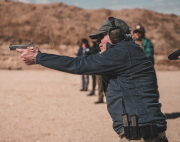What Iím doing in this case is keeping the head position anchored to the sights while I turn with kneesÖ even if the eye darts, I can still smoothly track the gun / irons in and across the target.
Itís like when we talked about picking up the dot on an optic on approach to the target. Itís like that.
The simpler the tracking, the more predictive the shooting and the less correction required.
I realized this when I was shooting PCC-ironsÖ the head has to stay anchored in line via the cheek weld. Even if the eyes dart to next target.
Thatís essentially what youíre trying to recreate with iron pistol for steel challenge IMOÖ a virtual cheek weld to the irons that keeps the head position constant in relation to the sights.
@rdtompki




 Reply With Quote
Reply With Quote


